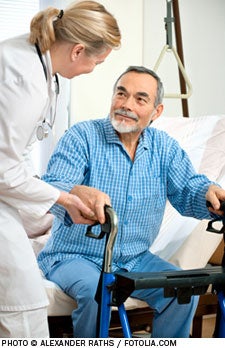Falls prevention program reduces serious incidents
 When its inpatient rate of falls with harm — or serious injury — started to climb, Harborview Medical Center, Seattle, decided it was time to take action.
When its inpatient rate of falls with harm — or serious injury — started to climb, Harborview Medical Center, Seattle, decided it was time to take action.
The goal was to reduce Harborview's falls per 1,000 patient days from about 5.5 to 3 and, more importantly, to cut the number of falls with serious harm, which had reached 21 percent before the program started, says Ross Ehrmantraut, R.N., CCRN, patient safety officer, Harborview.
A six-month pilot program in a 30-bed unit last year reduced falls with harm by 30 percent, going from the highest rate in the hospital to one of the lowest, he says. As the program has expanded throughout the entire hospital, the rate of falls with harm is down 18 percent over an 18-month period, he adds.
Ehrmantraut teamed up with staff doctor Elizabeth Phelan, M.D., associate professor, division of gerontology and geriatric medicine, University of Washington, to work with physicians, the pharmacy department and other staff to develop a multidisciplinary approach to falls prevention and to engage them in the program along with family members.
A critical element was establishing an evaluation tool for new patients that more precisely identified those at risk for serious injury from a fall, says Ehrmantraut.
The hospital is a Level 1 trauma center serving a substantial number of patients who have traumatic brain injuries or are undergoing alcohol withdrawal, he says. Patients who take certain medications that increase fall risk are now identified, too.
"The expanded evaluation process was a big key to the program, but the way it occurred developed an awareness of the issue among all disciplines," he says. "Everybody thinks about falls now, not just the nurses."




